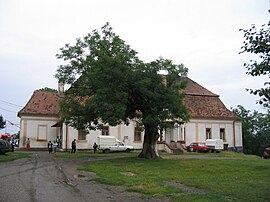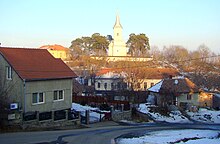| Voivodeni Vajdaszentivány | |
|---|---|
| Commune | |
 Zichy Castle Zichy Castle | |
 Coat of arms Coat of arms | |
 Location in Mureș County Location in Mureș County | |
 | |
| Coordinates: 46°42′0″N 24°38′0″E / 46.70000°N 24.63333°E / 46.70000; 24.63333 | |
| Country | Romania |
| County | Mureș |
| Government | |
| • Mayor (2020–2024) | Vasile Boer (PSD) |
| Area | 34 km (13 sq mi) |
| Elevation | 364 m (1,194 ft) |
| Population | 1,575 |
| • Density | 46/km (120/sq mi) |
| Time zone | EET/EEST (UTC+2/+3) |
| Postal code | 547650 |
| Area code | (+40) 02 65 |
| Vehicle reg. | MS |
| Website | voivodeni |
Voivodeni (also Sânioana or Sântioana; Hungarian: Vajdaszentivány, Szentivány; German: Johannisdorf, Johannesdorf) is a commune in Mureș County, Transylvania, Romania. It is composed of two villages, Toldal (Toldalag) and Voivodeni. The former village is much less populated than the latter.
This a commune is within a region known as Transylvania and is the centrally located in Romania. It is about 174 miles north of Bucharest, about 8 miles southwest of the city of Reghin, about 14 miles north of the county capital of Târgu Mureș, and about 86 miles northwest of Brașov. It is also at an average altitude of 1,230 feet, which is less than the average height where a landmass is considered a mountain (2,000 feet).
The commune has a hemiboreal climate with the average temperature as 48 °F (9 °C), with the warmest in July at about 70 °F (21 °C) and the coldest in December at about 21 °F (−6 °C). The average rainfall is about 31 inches a year, with about 5 inches in May and about 1.5 inches in February on average.
History
The first mention of the town was in 1332, under the name of Sancto Johanne. Archaeological finds have shown that the area comprising the Voivodendi village was first settled during the Bronze period. Find have showed settlement on a hill called Benghát, 374 metres (1,227 ft) tall, and Roman presence as made clear by an existing Roman road nearby. In the commune town of Toldal, there is definite finds of Roman settlers, who focused on agricultural production.
During the Kingdom of Hungary, the commune belonged to the Régen district. It had been was part of the Székely Land region of the historical Transylvania province. This was kept when the Kingdom was absorbed into the Austrian Empire and the Austro-Hungarian Empire. For instance, in 1876, there was an administrative reorganization of Transylvania, and it was attached to Maros-Torda County.
After the Hungarian–Romanian War of 1918–1919 and the Treaty of Trianon of 1920, the commune became part of the Kingdom of Romania, and was attached to Mureș County. In 1940, the Second Vienna Award granted Northern Transylvania to Hungary and the locality was held by Hungary until 1944. During this time, the small Jewish community in the area was exterminated by the Nazis. After Soviet occupation, the Romanian administration returned and the village became officially part of Romania in March 1945. Between 1952 and 1960, the commune fell within the Magyar Autonomous Region, between 1960 and 1968 the Mureș-Magyar Autonomous Region. In 1968, the region was abolished, and since then, the commune has been part of Mureș County.
The commune features the Zichy Castle, with relics from the Roman area and Hungarian presence. Notable people who have lived in the commune include politician István Dán and biologist (and geographer) Pál Samu, born on June 28, 1935.
Demographics

The highest number of people living in the commune, since recording of population information began in 1850, was in 1956, with a total of 2,849 inhabitants.
According to the 2011 census, the population of the Voivodeni commune was 1,756 inhabitants. This was a decrease from the last census, in 2002, when 1,957 were living in the commune. Of the inhabitants, about 60% were Hungarian, while the rest were either Romanian (28.4%) or Roma (9.05%), with about 2% having an unknown ethnicity. This means that the commune has a (Székely) Hungarian majority.
In terms of religious belief, most are Reformed (about 57%), while the rest are either Orthodox (about 28%), Seventh-Day Adventists (about 4%), Jehovah's Witnesses (3.4%), Roman Catholic (2.5%), or non-religious (1.6%). About 2% of the population had religious beliefs that cannot be determined.
Present day

The commune of Voivodeni is administered by a mayor and a local council which is composed of 11 councilors. The Mayor is Vasile Boer, from the Social Democratic Party, who was elected in 2012. The local council has the following composition of political parties after local elections in 2016:
- Social Democratic Party (Romania) – 7 seats
- Hungarian Democratic Union of Romania – 3 seats
- Hungarian Civic Party – 1 seat
Dance classes are held in the commune, like other parts of Transylvania, and churches made of wood are still standing. The economy of the town is based on agriculture and livestock. The municipality is also located on the regional road DJ154J Breaza – Glodeni, near the national road DN15 [ro] Târgu Mureș – Reghin.
Tourist attractions in the commune include the Reformed-Calvinist Church in the village of Voivodeni, built in the 15th century, and the Zichy Mansion in Vojvodina, constructed in the 18th century, to name two historical monuments. There are also several lakes, like Lacul Sate, where tourists can fish.
See also
References
- "Results of the 2020 local elections". Central Electoral Bureau. Retrieved 11 June 2021.
- "Populaţia rezidentă după grupa de vârstă, pe județe și municipii, orașe, comune, la 1 decembrie 2021" (XLS). National Institute of Statistics.
- Arcanum Kézikönyvtár: Historical-administrative place name book of Transylvania, Banat and Partium. Accessed on July 6, 2019. Resource is in Hungarian.
- Population numbers on 1.01.2009 in Romania. Archived from the original 10-09-2012. Cited on July 6, 2019.
- Structura Etno-demografică a României (Romanian). Archived from the original 7-29-2013. Cited on July 6, 2019.
- Physical distances are calculated according to the coordinates of settlements.
- Peel, MC; Finlayson, B L. "Updated world map of the Köppen-Geiger climate classification". Hydrology and Earth System Sciences 11: 1633-1644. doi: 10.5194/hess-11-1633-2007. Retrieved on July 6, 2019.
- NASA Earth Observations Data Set Index. NASA.
- NASA Earth Observations: Rainfall (1 month - TRMM).NASA / Tropical Rainfall Monitoring Mission
- Heinz Heltmann, Gustav Servatius (ed.): Travel Guide Transylvania. Kraft, Würzburg 1993, ISBN 3-8083-2019-2, p. 517.
- Institute of Archeology – Voivodeni. Accessed on July 6, 2019. Romanian language resource.
- Kovacs Lorant, "Assessment of the environmental value of the Zichy Castle Park in Voivodeni, Romania – Brief description," 2014.
- Census 1850-2002, last update 2 November 2008 (PDF, 1 MB, Hungarian).
- Official 2002 Census Statistics.
- Census of the Mureş County from 1850 to 2002.
- The population of Voivodeni in 2007 on the website of the National Institute of Statistics of Romania.
- "Population on January 1, 2009". INSSE. Retrieved on July 6, 2019. Archived from the original July 26, 2009.
- "Population and Housing Census 2002 - population of administrative units by ethnicity". Kulturális Innovációs Alapítvány (KIA.hu - Cultural Foundation for Innovation). Accessed July 6, 2019.
- Final results of the 2011 Census:"Tab8. Ethnic stable population – counties, municipalities, towns, communes ". National Institute of Statistics of Romania. July 2013. Accessed July 6, 2019.
- Final results of the 2011 Census:"Tab13. Stable population by religion – counties, municipalities, towns, communes". National Institute of Statistics of Romania. July 2013. Accessed on July 6, 2019.
- ^'List of Competitors Obtaining Mandates' (XLSX). Central Electoral Bureau for the 2016 local elections. Accessed July 6, 2019.
- Lucy Mallows and Rudolf Abraham, Transylvania (US: Bradt Travel Guides, 2012), p 105.
- Nuria Sanz, Living Wooden Culture Throughout Europe (Council of Europe, 2002), p 59.
- List of historical monuments of the Romanian Ministry of Culture, updated in 2015 (PDF, 12.7 MB, Romanian.
- Information on Lacul Sate at locuridepescuit.net, retrieved on July 6, 2019. Romanian language resource.
External links
- Official site of commune
- Wikimedia Atlas of Romania
- Wikimedia Atlas of Transylvania
- Voivodeni Castle
- Administrative map of the district
- Communes of Romania
- Romanian Law and Miscellaneous
- Map of Mureş County
